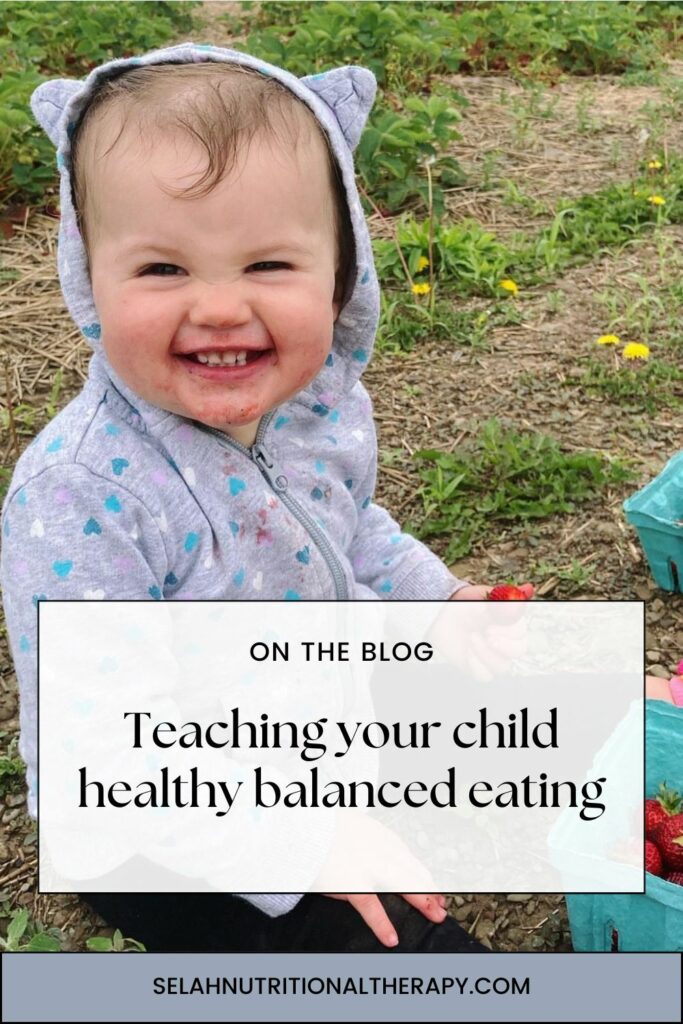Many parents would agree they want their child to eat a healthy balanced diet. But what if you don’t really understand what that means? How can you teach your child balanced eating if you don’t understand it. So while we are talking about children specifically here, you can apply these basic principles to yourself as well. The first step is to lead by example of course. But also, we’re going to go over what exactly the fundamental of eating is for a child. They may have a different palette, but the base principles of eating are nearly the same.
Macronutrients vs Micronutrients for balanced eating
Macronutrients and required in large amounts in the diet and are in great abundance in the body. These macronutrients are protein, fat, and carbohydrates. Micronutrients are the vitamins and minerals that are required for us to survive and thrive.
Some examples of micronutrients are: Vitamins A, B, C, and minerals like magnesium, calcium, zinc, iron. “Nutrients do not work in isolation. Each macro- and micronutrient works in synergy with other available nutrients.” (Basics of Nutrition p. 20)
The need of macro and micro nutrients ratios is greatly varied from person to person. However, the need for a balance in these macro and micro nutrients is needed for everyone.

The foundations of a balanced meal:
To receive the full benefits of a meal, all macronutrients must be present. This will create a diverse plate that will satisfy and sustain your child for a longer period of time. Some foods will provide more than 1 macronutrient at a time, but realize, each food is at least 1 macronutrient. In addition, adding a good source of fat onto a carbohydrate is a great way to incorporate more satisfying fat.
The Role of Protein, Fat, and Carbs
The constant demand for snacks from children is draining. Building plates according to their basic human needs will provide relief in this area. Here’s why: Protein: Essential for growth and repair of the body. Protein takes longer to be digested than fast burning carbohydrates, which keeps feelings of hunger at bay. Fat: Helps us to absorb necessary vitamins, like A, D, E, and K. Fat also regulates the speed in which we digest food and is an important source of long lasting energy. Carbohydrates: Provide a quick source of energy for the brain and muscles. When in combination with protein and fat, carbs can help fight infections, grow new body tissues and lubricate our joints. (B of N p.7)
Related: How to build a balanced meal
What would be an ideal balance of macronutrients for a child?
Each child (and adult) needs a proper balance of protein fat and carbohydrates to feel best. Each macronutrient has a different role in the body. Protein most known for its building material. Carbohydrates most known for a quick fuel source. While fat is most known for stable fuel for the brain (among other things). The ultimate goal is to create a balance of seeing each macronutrient present at each meal. Since the ratio changes from person to person individually, we’re just looking at step 1: making sure all macros are present.
Why is my kid always so hungry?
If not given the proper macronutrient balance and eating within a proper eating window, children can feel hungry all the time- just like adults! Increasing protein while being cautious of simple carbs is the best way to help balance their hunger levels. This keeps them from sugar/simple carb cravings when their blood sugar naturally dips. If you want to simplify this down- pay extra attention to breakfast. Are they at least getting 10-15g of protein for breakfast? Many are not. Increasing this protein at the very first meal, sets the rest of the day up for constancy in energy, hunger, and mood levels.
Getting to know micronutrients and where to find them:
Micronutrients only make up 1% of the body, but play a vital role in tissue growth, digestion and elimination, proper immune function, contracting and relaxing muscles, and more. The term micronutrients refers to the vitamins and minerals we need in our bodies. Most of these vitamins and minerals cannot be made- and must be gained by the foods that we eat.
To find these significant micronutrients, food quality is very important, and will determine how many of these vitamins and minerals are present.
- Colorful fruits and vegetables
- Local and in-season produce will be even better
- Nuts, seeds, and legumes
- Pasture raised meats and eggs
- Raw and cultured foods
- Wildcaught seafood
Specific examples include:
- Vitamin A: Fish, carrots, broccoli
- Vitamin B: Whole grains, meats, eggs
- Vitamin C: Citrus, peppers, strawberries
- Magnesium: Greens, nuts, seeds
- Calcium: Yogurt, broccoli, oranges
- Zinc: Meat, whole grains, shellfish

Meal plan example of a balanced diet for kids
Breakfast
- Eggs and Toast: Egg cooked to choice (P) Toast (C) Nut butter (F)
- Oatmeal with sausages: Oats (C) Maple syrup (C) Grass-fed butter (F) Sausages (P)
- Yogurt Parfait: Whole milk yogurt (P+F) Berries (C) Granola (C)
Lunch
- When They Want Their Favorite Chicken fingers: Chicken Fingers (P) Apple (C) w/ Peanut butter (F)
- Ham and Potato soup: Ham (P) Potato & Onion (C) Cheese (F)
- Snack Lunch: Hard boiled egg (P) Cottage cheese (F) Carrot sticks (C) Popcorn (C)
Dinner
- Chicken Quesadilla: Tortilla shell (C) Chicken (P) Cheese (F)
- Chicken Thighs & Green Beans: Chicken (P) w/ avocado oil (F) Green beans (C) w/ grass-fed butter (F)
- Broiled Salmon Dinner: Salmon (P) Rice (C) w/ grass-fed butter (F) Broccoli (C) w/ grass-fed butter (F)
For easy access to goof quality foods for your child free of artificial dyes, high fructose corn syrup etc, check out Thrive Market and get 40% off your first order. First responders, teachers, nurses, veterans and low income families even have access to a free membership!
“People who love food are always the best people.”
-Julia child
Using their curiosity to your advantage
Consider this, that coconut at the grocery store that they’ve been begging to try. Buy it. Have fun with it. See their curiosity light up. Have a chocolate tasting party. This is another avenue for you to teach your child about balanced eating.
“What kind do you like most? What if you paired these two together?”
Consider planting a vegetable garden together- their commitment can be surprising. Or have them choose an entree or a side for a meal where you provide the options. Cooking with children is complicated.
It’s messy.
It’s stressful.
But the reality is- they love it! And they love what they make!

This is also a great opportunity to teach them about what goes into food- and the importance of balance. In action at the table, open up the door for investigation with meals. “Would you like to salt your broccoli? What part do you like best?” Inviting them into the eating experience as much as possible, can be enjoyable for both of you.
What if eating is already a struggle?
Children often respond best to gentle exposure rather than expectations and rules. Eating should be an enjoyable experience for everyone. If your child is miserable with what is required at meal time, consider how you feel with the stress and pressure added to make sure they eat the perfect meal or what you decided was “enough”. If you can take a step back and have your child view their food through a discovery and investigation process, the time can be more enjoyable for everyone.
Children are often extra picky and extra unpredictable. That dinner you made last week that they LOVED- tonight they won’t touch it. They’ll eat olives at your mother-in-laws- yet at home, they can’t stand them on their plate. Stress at mealtime has the potential to ruin an evening. So how can you bridge the gap between their independence and your set boundaries?
Even if the meal isn’t going as you planned, it is still an opportunity to teach your child about balanced eating.
More information on what exactly to buy at the store or plan for your meals is located here.
This post guides you through the step by stop process of upgrading your grocery choices and cleaning out your pantry so you can choose what best for your family. I even have clickable grocery orders available for you.
*This post may contain affiliate links, which means I may receive a small commission at no extra cost to you. I do not recommend products that I have not personally vetted.




Thanks for sharing the eating plan along with the reasons balanced and healthy foods are better for our kiddos. Diet does affect their behavior and so many other things. Great article.
Thank you for reading!